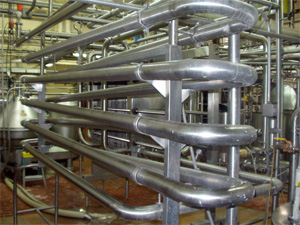 |
| Balance Tank |
The starting point of a pasteurizer is always the balance tank. Milk from the raw milk silos is pumped into the balance tank which is designed to overflow, if necessary, into the floor. The design ensures that there is an air gap between the raw milk in the balance tank and the pasteurized milk in the pasteurized side of the pasteurizer.
 |
| Centrifugal Pump |
A booster pump (centrifugal pump) moves raw milk from the balance tank into the raw side of the regenerator (plate heat exchanger) and creates a positive pressure in the raw regenerator. Without a booster pump, milk would be drawn from the balance tank under sub-atmospheric pressure by the timing pump and the efficiency of the regenerator could decrease if air gaps were created in the raw side of the regenerator.
 |
| Plate Heat Exchanger |
The heat exchanger is made up of thin steel plates pressed against each other to create narrow passages. Raw and pasteurized milk flow in counter current fashion in opposite sides of the plates separated only by the think steel sheets and the gaskets that keep the plates against each other. The heat exchanger is broken down into 3 or more sections: regenerator (product to product), heater (hot water to product), and cooler (ice water to product).
 |
| Heat Exchanger Plate and Gasket |
Notice how easy it would be for raw milk to skip past the gasket and commingle with the pasteurized milk on the other side. Pasteurizers are required to maintain a higher pressure in the pasteurized side than in the raw side at all times (critical control point): start up, production, and even during catastrophic shutdowns when the power goes off completely.
After milk passes through the raw side of the regenerator (central section in the plate heat exchanger with hot pasteurized milk in the opposite side of the plates) its temperature has increased greatly (90% of target temperature) and is drawn out by the timing pump and pushed into the heater (final section in the plate heat exchanger) where it reaches the final target temperature.
 |
| Holding Tube |
Milks comes out of the heating section of the plate heat exchanger and flows through the holding tube (pipe) pushed by the timing pump. The two critical control points in the holding tube are the flow rate of the milk, which determines the holding time, and the temperature at the end of the holding tube. Both must be above the minimum required pasteurization times and temperatures.




